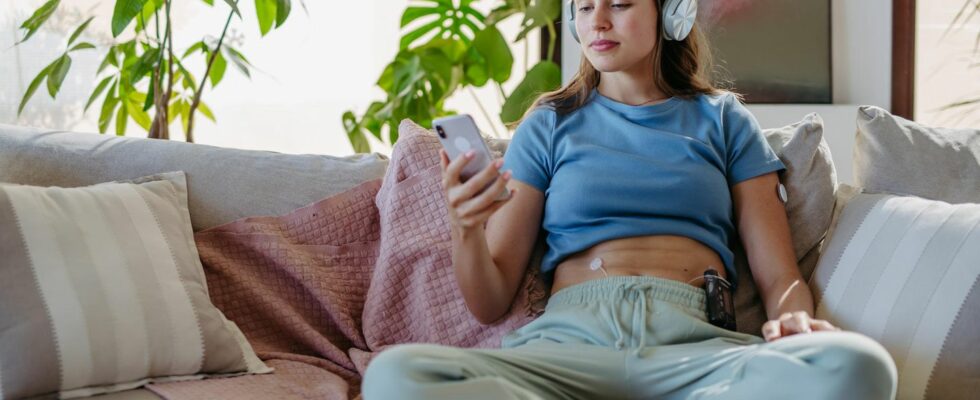Blood sugar sensor
Tips and tricks for measuring your own blood sugar
© Halfpoint / Adobe Stock
A blood sugar sensor against energy holes? Our colleague Daniela Stohn tried it out.
I’m on it again,for the third time, even though I know it’s annoying and will ruin my enjoyment of eating for a while. I’ve been wearing a sensor on my arm for a few days now blood sugar level constantly measures. And I check my smartphone about every five minutes to check my blood sugar curve: Is my fasting blood sugar less than 100 milligrams per deciliter in the morning? Are there peaks over 140 more often than I would like? And is my value in the range that experts like the doctor Peter Attia specify, i.e. around 100 plus/minus 15, without major fluctuations?
In order to understand the hype about blood sugar, you have to briefly explain how it actually works. When we eat pasta, bread or cake, the carbohydrates they contain are first broken down into their individual parts, the glucose. The blood sugar level rises as a result of their intake, the pancreas releases the hormone insulin, which transports the blood sugar from the blood into the cells and stores it there. If our metabolism is healthy, the blood sugar level rises after eating, but then drops steadily again. It becomes problematic if it stays up. Frequent glucose spikes also stress the body and lead to food cravings. They make you tired, irritable and unfocused. In the long term, they can also increase the risk of diseases such as type 2 diabetes, heart problems or dementia.
In order to prevent all of this and avoid energy holes, I would like to know how my body reacts to which foods. Because it varies from person to person. In principle, the following applies: complex carbohydrates in vegetables and whole grain products cause blood sugar to rise more slowly than simple ones in sugar or white flour products. An athlete can metabolize more than someone who doesn’t exercise, and many people can cope better with glucose in the morning than in the evening. But not all of them, and that’s what makes the measurement so exciting. I, for example, and I learned this in my measuring phases, metabolize pasta much better than potatoes – they make me sluggish and weak. White bread is okay for me in the morning, but in the evening it causes my blood sugar levels to skyrocket. Eating bread late also causes my blood sugar to fluctuate at night and makes me sleep restlessly. And – not at all good for my climate balance: oat milk produces a stark glucose spike, whereas cow’s milk produces a significantly flatter spike.
Draw your own conclusions: What helps and what doesn’t?
I have a lot of aha moments and am excited to see how my body works. I experiment: In the evening after exercise, fried eggs with wholemeal bread (blood sugar peak) versus vegetable omelette (flat line), in the morning Bircher muesli (high) versus seed bread with cheese (flat). Chocolate as a snack or after the main meal – a huge difference, since then I’ve eaten it primarily as a dessert. A glass of water with 1 tablespoon of apple cider vinegar before the cappuccino and once without – not a big difference with cow’s milk, but with oat milk. I get hypoglycemia relatively quickly and notice that the curve then fluctuates more throughout the day. And I’m learning that when I see my curve skyrocket after a plate of spaghetti, I move to flatten it again. I distinguish good blood sugar spikes (after intense workouts, stress, cold baths) from the not-so-good ones (cake in the afternoon, only sleeping for five hours). What I’m still learning thanks to apps that accompany measuring with tips and information: Easy cardio training is the most effective way to get glucose out of the bloodstream. Eating fiber, fats and proteins before carbohydrates flattens the curve.
But, and this is important to know: It is not always clear why blood sugar spikes occur, because stress and exercise also influence it. And it’s not really well researched yet how bad they really are for healthy people. And, attention: It can be scary if the curve suddenly shoots up sharply. When I had scones with jam for breakfast one morning and then didn’t eat for a long time, I was exhausted and fell into an energy hole. When I gorge myself on fish and fried potatoes in the evening, my blood sugar level shoots up to over 200 and the display glows menacingly red. I’m pretty distraught for an hour, then the value goes down again.
My conclusion: Even small changes can do a lot to raise your energy level. And yet I’m happy when the thing on my upper arm is gone after 14 days and no longer controls me. And the chocolate tastes better…
